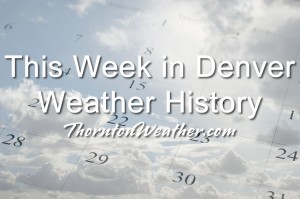
March is the Mile High City’s snowiest month as moisture-laden storms can oftentimes bring our heaviest snows. In our look back at this week in Denver weather history we see many occasions where monstrous snowstorms buried the city.
From the National Weather Service:
2-4
In 1963…heavy wet snow was accompanied by strong gusty winds across metro Denver. Snowfall totaled 11.6 inches at Stapleton Airport where north winds gusting to 44 mph caused much blowing and drifting snow. Hazardous driving conditions resulted in many traffic accidents.
In 1976…snowfall totaled 8.0 inches at Stapleton International Airport where…on the 4th…northeast winds gusted to 31 mph reducing the visibility to as low as 1/4 mile. Maximum snow depth on the ground was 7 inches. Nine inches of snow were measured in Boulder.
3-4
In 1932…a dust storm occurred on the 3rd during the late afternoon. North winds gusting as high as 38 mph behind a cold front kicked up much blowing dust. Light snow developed during the evening and continued through the early morning of the 4th. Snowfall totaled 2.7 inches.
In 1934…strong winds raked Boulder. A wind gust to 62 mph was recorded at Valmont just east of Boulder. The strong winds caused hundreds of dollars of damage in Boulder.
In 1981…the most vigorous snow storm of the season struck the state…closing many schools and most highways connecting Denver…Colorado Springs…and Limon. North winds gusting to 43 mph whipped nearly 10 inches of snow in Denver into 3-foot drifts and snarled traffic on the morning of the 4th. Snowfall totaled 9.8 inches at Stapleton International Airport.
In 1989…a storm dumped 2 to 6 inches of snow across metro Denver. The snow caused 2-hour air traffic delays at Stapleton International Airport where 3.0 inches of snow fell and north winds gusted to 23 mph on the 3rd. There were many traffic accidents across metro Denver. I-70 was closed east of Denver for a time on the 3rd.
In 1991…high winds raked the eastern foothills. Wind gusts of 60 to 90 mph were common with 119 mph recorded at Wondervu southwest of Boulder…106 mph on Shanahan Ridge and 92 mph at Table Mesa…both in southwest Boulder. Several trees were uprooted and traffic signs and lights blown over. Flying debris caused damage to homes… Buildings…and cars.
In Boulder…a stop sign was blown onto a car. There were no reports of injuries. Southwest winds gusting as high as 48 mph briefly reduced the prevailing visibility to as low as 1/16th mile in blowing dust at Stapleton International Airport on the 4th.
3-5
In 1961…snowfall totaled 8.3 inches at Stapleton Airport over the 3-day period with most of the snow…4.4 inches…falling on the 3rd. Winds were generally light gusting to only 23 mph.
4
In 1887…snowfall was only 0.1 inch. This was the earliest last measurable snow of the season.
In 1971…a wind gust to 102 mph was recorded at the National Center for Atmospheric Research in Boulder. A wind gust to 83 mph was measured at the National Bureau of Standards. In downtown Boulder…sustained winds reached 35 mph with gusts as high as 57 mph. No significant damage was reported. West winds gusted to only 28 mph at Stapleton International Airport.
In 1982…brief heavy snow accompanied by a few thunderstorms struck metro Denver. Lightning struck a house in Arvada setting it afire. The thunderstorm produced 5 inches of snowfall in a 2-hour period in Wheat Ridge. The snow made roads very icy and slick causing a 59-car pile-up on I-70 in north Denver. Snowfall with thunder totaled only 1.3 inches at Stapleton International Airport.
In 1997…a fast moving pacific storm produced heavy snow in the foothills. Snowfall at conifer measured 9 inches. Only light snow fell elsewhere over metro Denver. Snowfall totaled only 1.2 inches at the site of the former Stapleton International Airport. North northeast winds gusted to 28 mph at Denver International Airport.
Continue reading March 4 to March 10 – This Week in Denver Weather History
